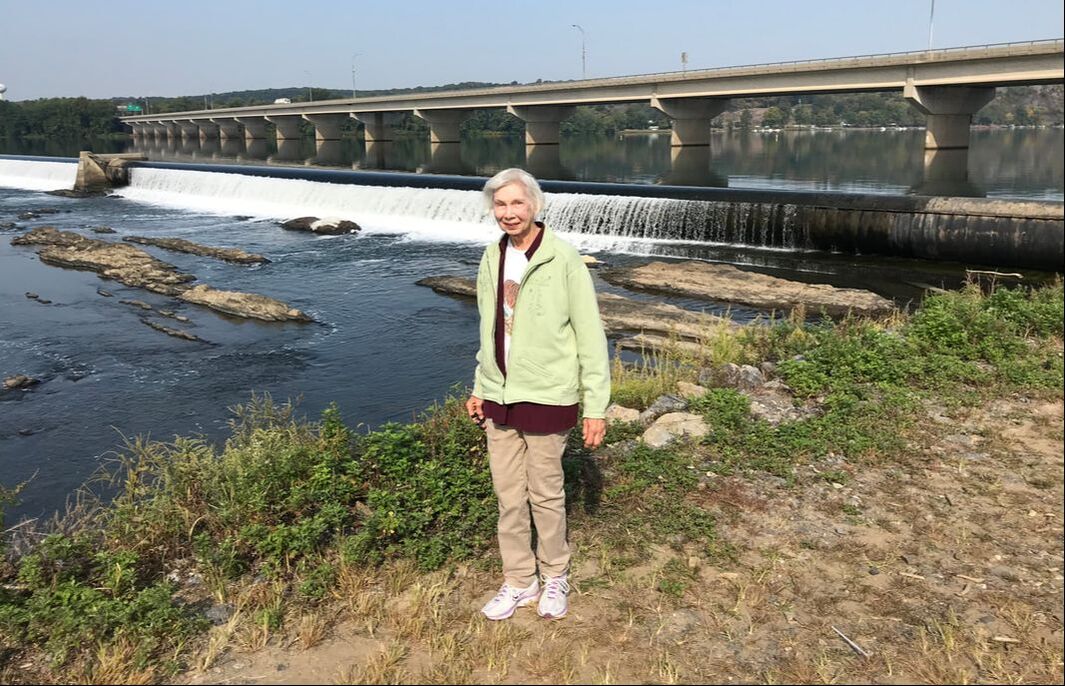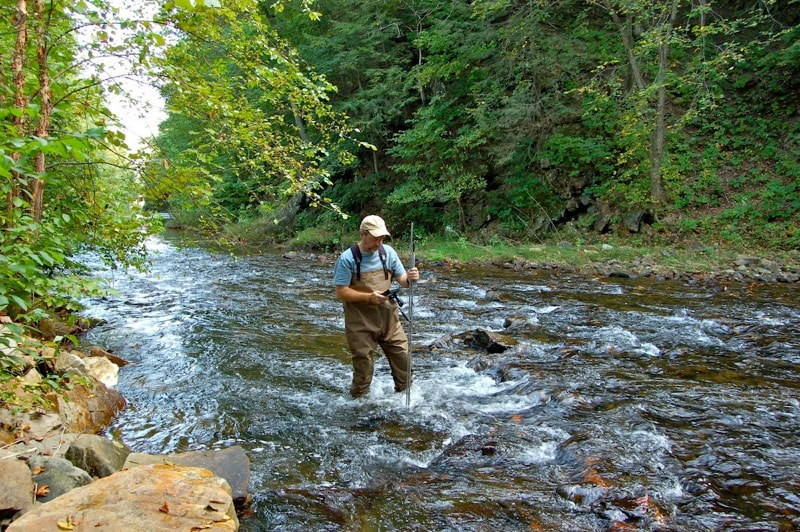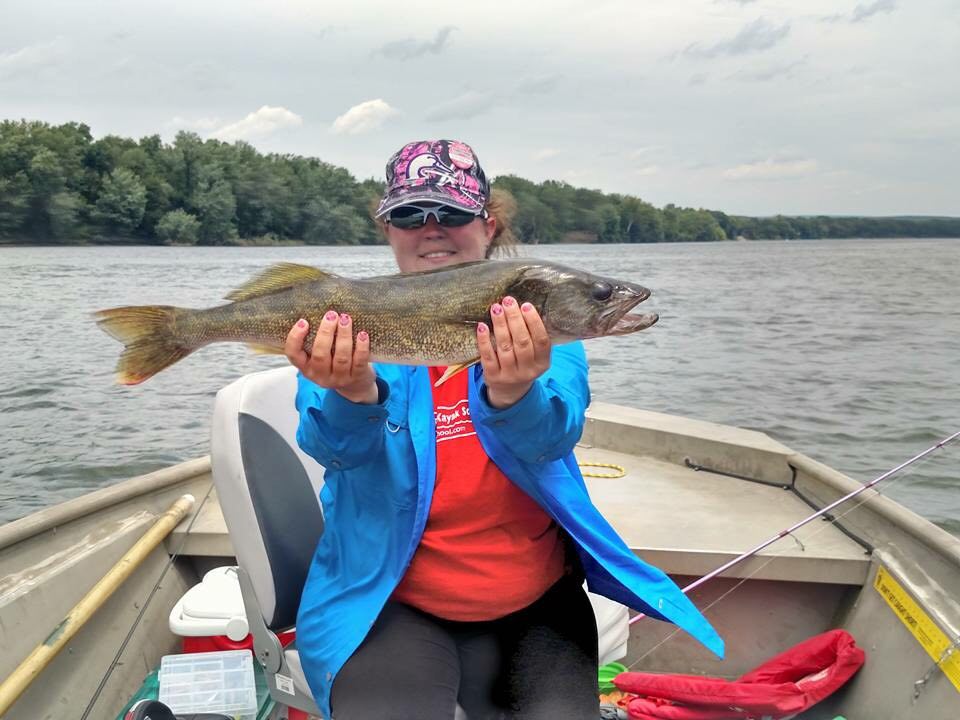|
How low is the water table within our river and extended network of tributaries? "The water is about as low as I ever have seen it," said Ken Maurer, owner of Southside Bait and Tackle in Sunbury and longtime river fishing guide. "The boating is limited -- I cracked a well on my boat this year for only the second time in 16 years. Navigating with a jet boat is even really difficult right now. A lot of people wrecked their boats this year." According to Benjamin Hayes, director of the Watershed Sciences and Engineering Program at Bucknell University, many of the riffle-glide bedforms in the West Branch of the Susquehanna River between Muncy and Lewisburg were exposed or only under a few inches of water for distances of a half-kilometer or more. "Canoers gave up. Kayakers had to pull their boats. Prop engines got chewed up and even jet engines had to rev up over the pools so the bass boats could sort of glide over the riffles," he said, adding that rocks and old canal dam cribbing structures were left high and dry through the area. "You could have rode your mountain bike across the river at Lewisburg in August!" Dr. Brian Mangan, director of the environmental program and professor of environmental science and biology at King’s College, has been studying the North Branch of the Susquehanna River for 39 years near Berwick and has a dataset that stretches back to 1972. His research shows that while the river flow was low this year, it was not the lowest. For instance, the flow measured in September of 1999 was noticeably lower -- but that doesn't mean the current low water table isn't drastically impacting our greater watershed. "River flow, as water volume, is a major factor in the function and ecology of lotic (referring to water bodies that are in motion such as rivers, streams and creeks) ecosystems," he said. "For example, some organisms that can't move from their locations as water recedes will, unfortunately, fund themselves high and dry." Even organisms that can move may be forced to share the limited space (volume) that remains, Mangan added. "On top of that, water quality variables, such as oxygen and temperature, can reach or fall below levels required by organisms and levels of pollutants (both natural and from humans) can become concentrated," he said. Through the years, Mangan has found a number of small fish kills resulting from droughts similar to the one we have been facing. "One that comes to mind was a group of hundreds of Tesselated Darters that I found trapped in a warm, low-oxygenated backwater along the shore of the river near the lab that I worked," he said. "These low-water events can have negative consequences for localized populations of organisms." Robert Lorantas, Warmwater Unit Leader for the Pennsylvania Fish and Boat Commission, has been part of a study examining smallmouth bass abundance and stream discharge from the 1980s through 2004. The study, he said, offers a different take on what you'd expect from low water situations and fish populations. "In most reaches studied in years where discharge or flow was above average, fewer young smallmouth bass were collected," he said. "Contrarily, in severe drought years and low flow years, an abundance of smallmouth bass were collected." Lorantas and his colleague have developed a few assumptions that support this phenomenon. "Our 'theory' is that expanded 'shallow water habitat' in drought or low-discharge situations limited predation and essentially created expanded protected habitats for young smallmouth bass and other small fish," he said. "Also, higher flow may have dislodged and 'damaged' young (depending on severity) or accommodated easier access by large predatory fish into the shallow realm of small or young fish." This July, Lorantas recorded an "average abundance" of young of year smallmouth bass in his collections. "We continue to process and analyze data collected this year," he said. "There are a myriad of influential circumstances upon fish abundance associated with lower flow." Among the influencing circumstances that come from low water levels and cause a larger ripple effect is water temperature. "Generally, it is easier to heat or cool smaller volumes vs. larger volumes of water," said Mangan. It is a concept that Maurer witnessed last week while guiding a trip on the river. "When we went out at 9 a.m., the water temperature was 56 degrees. When we pulled out at 3 p.m., it was 63 degrees. In six hours, the water warmed six degrees and that shows the temperature swings you can get," he said. "However, if you get a couple of cloudy days and cold nights, the water temperature can drop quite a bit, so it is a big deal. I've actually used my fish finder more lately for water temperature than depth readings." However, Mangan added, lower water volumes and temperature shifts can be much more complicated than it appears on the surface -- literally. "Baseflow -- the contribution of sub-surface water to streams and rivers -- can be a substantial portion of the volume in a lotic ecosystem," he said. "And baseflow, which usually contributes cooler water to these systems, tends to lag behind surface flow. In other words, the spigot that shuts off precipitation and overland flow to streams during droughts doesn't also automatically shut off the baseflow spigot at the same time." Hayes, while mapping bedforms and river temperatures this summer, took notice to how stressed various smallmouth bass populations appeared. "They were seeking refuge in the marginal channels, which lacked any cover. Temperatures during the day often exceeded 80 degrees for several days in July," he said. "I could walk right up to them and practically touch them with my hands." Jolene Connelly, of Selinsgrove, a educator and former American Canoe Association Level 3 kayaking instructor, admits that time on the river has gotten much more difficult.
"Sadly, due to the water levels, I haven't been in the boat anywhere near as much as I'd like to be," she said. "With duck season coming up, we're looking at other options. Typically we use a boat blind, but I'm not sure we are getting that out. I may need to kayak or canoe to an island and set up a blind there." However, she notes one positive about the low-water situation. "Right now, when you are on the river, you can see some of the underwater structure that you typically can't when water levels are normal," she said. "Even if that doesn't help you right now, you can see and scout out those ledges and other structures that you may want to fish later when the water is deeper." Maurer agreed. "The water is low and clear, and you can see rocks and ridges you'd never see otherwise," he said. "There are areas on the North Branch where you can see eight to nine feet which is unusual for the North Branch. Lately, I am seeing stuff out there every time that surprises me."
6 Comments
Don Williams
10/11/2020 07:48:53 am
1999 was 20+ years ago. When did the wholesale consumptive use of river and groundwater for fracking begin, and how many billions of gallons have been extracted over the last 10+ years. Why is that not mentioned anywhere in this article? I'd like to see some hard data in response to my question vs. what will probably be offered. Thank you.
Reply
John Zaktansky
10/12/2020 06:37:10 am
Mr. Williams ... Good question. This package was developed to be focused on the lower water table from this summer's drought, but I do have plans to do a much deeper dive into water level trends over time in regards to water draws from the fracking industry and other sources. I am very interested to see what data we are able to dig up and share.
Reply
Barb Jarmoska
10/12/2020 11:19:28 am
I was thinking the same thing as Don Williams, and am glad to see Riverkeeper John Z's answer.
Reply
Nicholas Entz
10/12/2020 08:24:09 pm
I have spent time around time Hidden Valley and Wallis Run area all my life and I can verify the severe decline in aquatic life and other wildlife. Thank you Barb. I appreciate you comment and insight.
Reply
4/16/2023 11:16:29 pm
The low water levels in the river and tributaries are causing difficulties for boaters and affecting the ecosystem. Riffle-glide bedforms are exposed, leaving rocks and old canal dam cribbing structures high and dry. Canoers and kayakers are having to navigate with difficulty, while boat engines are being damaged by the shallow water. The low water levels are causing concerns for the health of the ecosystem, and it is important to take measures to mitigate the impact.
Reply
Leave a Reply. |
AuthorsRiverkeeper John Zaktansky is an award-winning journalist and avid promoter of the outdoors who loves camping, kayaking, fishing and hunting with the family. Archives
April 2024
Topics |





 RSS Feed
RSS Feed